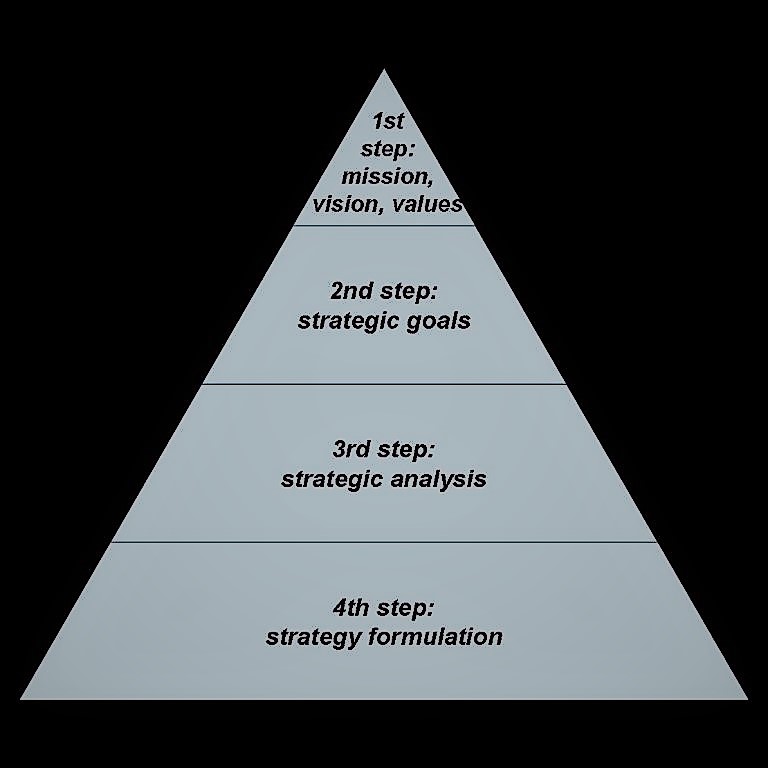When a community plans to implement sustainable sanitation and water management tools, it is crucial to develop a community strategy defining steps that need to be taken to achieve the ultimate goal. Strategy development thus needs to be considered after the future visioning of the community members, but before taking any implementation action. As strategy development is not a well-defined tool but one with many different approaches (especially in business studies), this factsheet will remain general when explaining necessary steps for developing a strategy.
A strategy is a method or plan chosen to bring about a desired future, such as the achievement of a goal or the solution to a problem (BUSINESS DICTIONARY n.y.). First introduced in a military sense, strategy development is now used by companies, NGO’s, and communities. Although the term is mainly used in business studies, it is crucial for a successful change in sanitation and water management: after a community has done the preliminary assessment of the current status (see this category on Exploring Tools section) and has a clear vision of what should be done in the water and sanitation sector, it needs to develop a long-term strategy to define how to reach the appropriate goals.

Generally, the development of the strategy is necessary in order to:
- Define a consistent approach to the local Sustainable Sanitation and Water Management action plan;
- Help maintain the overall direction of local policies and prevent these policies from being affected by short-term political interests or changes in elected representatives and staff;
- Direct and focus actions and projects to be carried out as part of the local Sustainable Sanitation and Water Management action plan; and
- Identify cases where it is necessary to reach outside local government boundaries to gain the support and capacity necessary to achieve certain objectives (PHILIP et al. 2008).
Even though developing a strategy can be seen as an art, it necessitates a systematic process that helps to consider all main steps: at first, the mission, vision and values need to be developed or reaffirmed. In a second step, the concrete goals and outcomes that would represent the achievement of the vision need to be determined. The identification and analysis of key issues, including internal and external forces that might affect the strategy, has to be conducted in a third step. Finally, the new strategy needs to be formulated and the case for change needs to be created (KAPLAN et al. 2008).
Adapted from PHILIP et al. (2008)
For the development of a strategy within a community, all important stakeholders need to be involved to ensure the acceptance and thus the sustainability of the strategy.
- Local government: Should oversee the establishment and coordination of a steering group to develop the draft strategy; draw up ‘Terms of Reference’ for the steering group; and take responsibility for finalising the strategy.
- Steering group: Senior staff from relevant local government departments (for example water services, land-use planning, waste management, etc.) should be nominated to make up a steering group tasked with developing the draft strategy. A process for organising meetings and chairing the group should be decided upon. The steering group should agree on and sign ‘Terms of Reference’ for meeting and developing the strategy, which must be clear from the start to ensure that the process is transparent.
- Stakeholders: The most important stakeholders should be identified and included in the consultation period of the draft strategy.
- Local community: The local community should be informed about the new strategy by local media campaigns, because awareness raising (see PPT) is crucial for the acceptance of the new strategy within the society. For the same reason, it is always important to consider socio cultural issues when developing a new strategy.
Adapted from KAPLAN et al. (2008)
The following steps are a framework for developing a community strategy:
1st Step – Crafting Mission, Vision, and Value Statements
- The mission is a brief, typically one-sentence statement that defines the fundamental purpose of the community. It should include what the community provides for its residents and inform about the overall goal they have come together to pursue.
- The values of a community prescribe its desired behaviour, character, and culture.
- The vision is a concise statement that defines the mid- to long-term goals (three to ten years) of a community. For more information, see visioning.
2nd Step – Define and Decompose Strategic Goals
Quantifying the vision makes it possible to integrate target setting with the exploration of feasible strategies. The vision’s quantified success factor becomes the reference point for judging the feasibility of strategies. Therefore, in this step, the specific goals referring to the vision should be developed. Possible goals could concern issues on both the hardware (technical) and the software (social, political, cultural, etc.) side.

3rd Step – Strategic Analysis
With a clear picture of what it needs to achieve, the community must now perform an internal and external analysis.
- External analysis: The external analysis should mainly include the existing policies and legal framework. National and international guidelines or restrictions should necessarily be considered when developing the strategy. Also, environmental issues like water pollution, climate change and soil degradation are important external factors.
- Internal analysis: For the internal analysis, it is most important to consider background information like socio cultural issues to find out about the communities’ own performance and capabilities.
After performing the external and internal analysis, a SWOT analysis should be conducted.
4th Step – Strategy Formulation
The strategy formulation consists of many parts:
- The strategy needs to be formulated and documented, including creating a community action plan. This ensures that the change of the strategy is linked to the planning and execution process.
- The developed strategy should be transparent for all community members. Therefore, awareness raising (see PPT), for example through local media campaigns, is of great importance.
- Furthermore, the new strategy should be adapted in the policies and legal framework of the community to enable its enforcement.
Even though these four steps can be seen as a framework for developing a strategy, the concrete process of strategy development depends on the community/the local context. Special pitfalls and success factors, which should be taken into consideration, are listed below.
Adapted from PHILIP et al. (2008)
Uncooperative colleagues (-): Poor communication within a local government may mean that key staff members in the relevant departments are unwilling to spend valuable time participating in a steering group for a Sustainable Sanitation and Water Management process they know little about. If they are to be convinced of the need to commit to the process, each department must be made aware of the importance of SSWM and how it is linked to their area of interest.
Lack of political support (-): Without political support from higher levels, strategies will remain as well-intentioned plans that are unlikely to ever come to fruition. Financial backing and technical know-how are examples of higher-level assistance that will be necessary to turn a strategy from paper into action. Long-term political support is therefore essential.
Awareness raising (+): Raising the public profile of a long-term strategy will help society understand the issues at stake and the reasons for proposed changes. Such awareness can alter behaviour and increases the likelihood that society will accept and support the strategy.
Socio-cultural issues (+): Socio-cultural issues of the concerned community need to be taken into account to ensure the sustainability of the strategy development outcomes.
After the visioning has taken place, the community needs to develop a long-term strategy with specific goals concerning the water and sanitation sector. Afterwards, a community action plan can be developed to make the visions come true. These preparation steps are very important before taking any implementation action to ensure the sustainability of the change process. In this context, awareness raising and transparency are also important success factors.
Developing the Strategy: Vision, Value Gaps, and Analysis. Balanced Scorecard Report
Although this document is mainly prepared for companies, it also helps to find out about strategy development within a community as it shows the most important steps to take.
KAPLAN, R. S. NORTON, D. P. BARROWS, E.A. (2008): Developing the Strategy: Vision, Value Gaps, and Analysis. Balanced Scorecard Report. Boston: Harvard Business School URL [Accessed: 08.07.2019]Local Government and Integrated Water Resources Management (IWRM) Part III: Engaging in IWRM – Practical Steps and Tools for Local Governments
The set of materials entitled “Local Government and Integrated Water Resources Management (IWRM)” aims to assist Local Governments with active participation in IWRM. The materials are primarily targeted at local government officials, but are considered equally useful for individuals and organisations that work with local governments in the management of water resources.
PHILIP, R. ANTON, B. BONJEAN, M. BROMLEY, J. COX, D. SMITS, S. SULLIVAN, C. A. NIEKERK, K. van CHONGUICA, E. MONGGAE, F. NYAGWAMBO, L. PULE, R. BERRAONDO LOEPEZ, M. (2008): Local Government and Integrated Water Resources Management (IWRM) Part III: Engaging in IWRM – Practical Steps and Tools for Local Governments. Freiburg: ICLEI European Secretariat GmbH URL [Accessed: 17.04.2012]Developing the Strategy: Vision, Value Gaps, and Analysis. Balanced Scorecard Report
Although this document is mainly prepared for companies, it also helps to find out about strategy development within a community as it shows the most important steps to take.
KAPLAN, R. S. NORTON, D. P. BARROWS, E.A. (2008): Developing the Strategy: Vision, Value Gaps, and Analysis. Balanced Scorecard Report. Boston: Harvard Business School URL [Accessed: 08.07.2019]Local Government and Integrated Water Resources Management (IWRM) Part III: Engaging in IWRM – Practical Steps and Tools for Local Governments
The set of materials entitled “Local Government and Integrated Water Resources Management (IWRM)” aims to assist Local Governments with active participation in IWRM. The materials are primarily targeted at local government officials, but are considered equally useful for individuals and organisations that work with local governments in the management of water resources.
PHILIP, R. ANTON, B. BONJEAN, M. BROMLEY, J. COX, D. SMITS, S. SULLIVAN, C. A. NIEKERK, K. van CHONGUICA, E. MONGGAE, F. NYAGWAMBO, L. PULE, R. BERRAONDO LOEPEZ, M. (2008): Local Government and Integrated Water Resources Management (IWRM) Part III: Engaging in IWRM – Practical Steps and Tools for Local Governments. Freiburg: ICLEI European Secretariat GmbH URL [Accessed: 17.04.2012]Getting communities engaged in water and sanitation projects: participatory design and consumer feedback
Community engagement in water and sanitation service delivery is key for ensuring project sustainability and accountability. This Topic Brief looks at community engagement approaches used by WSUP in three cities within the African Cities for the Future (ACF) programme: Antananarivo (Madagascar), Kumasi (Ghana) and Maputo (Mozambique). The Topic Brief highlights some of the key challenges, and ends with practical recommendations for programme managers about how to engage low-income communities in the design of water supply and sanitation projects.
WSUP (2013): Getting communities engaged in water and sanitation projects: participatory design and consumer feedback. London: Water & Sanitation for the Urban Poor (WSUP) URL [Accessed: 30.06.2019]

